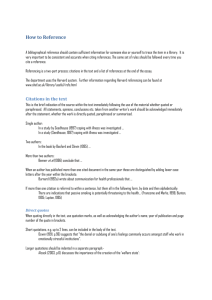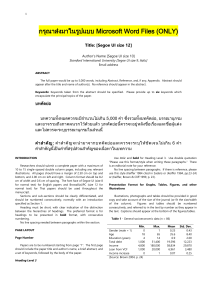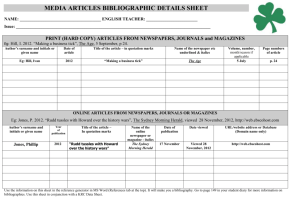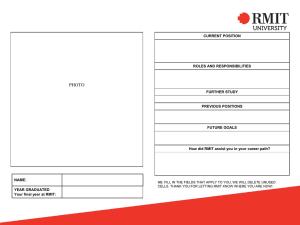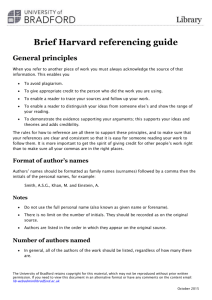Harvard referencing - Library extended guide
advertisement
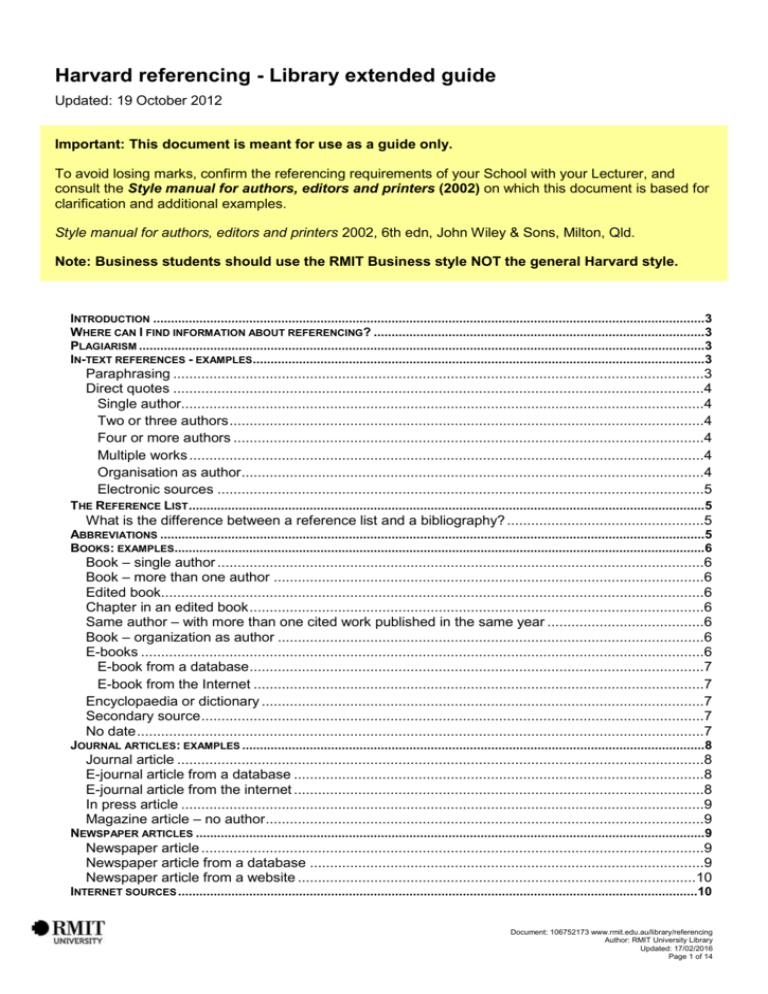
Harvard referencing - Library extended guide Updated: 19 October 2012 Important: This document is meant for use as a guide only. To avoid losing marks, confirm the referencing requirements of your School with your Lecturer, and consult the Style manual for authors, editors and printers (2002) on which this document is based for clarification and additional examples. Style manual for authors, editors and printers 2002, 6th edn, John Wiley & Sons, Milton, Qld. Note: Business students should use the RMIT Business style NOT the general Harvard style. INTRODUCTION ...........................................................................................................................................................3 WHERE CAN I FIND INFORMATION ABOUT REFERENCING? .............................................................................................3 PLAGIARISM ...............................................................................................................................................................3 IN-TEXT REFERENCES - EXAMPLES ...............................................................................................................................3 Paraphrasing ....................................................................................................................................3 Direct quotes ....................................................................................................................................4 Single author..................................................................................................................................4 Two or three authors ......................................................................................................................4 Four or more authors .....................................................................................................................4 Multiple works ................................................................................................................................4 Organisation as author...................................................................................................................4 Electronic sources .........................................................................................................................5 THE REFERENCE LIST .................................................................................................................................................5 What is the difference between a reference list and a bibliography? .................................................5 ABBREVIATIONS .........................................................................................................................................................5 BOOKS: EXAMPLES.....................................................................................................................................................6 Book – single author .........................................................................................................................6 Book – more than one author ...........................................................................................................6 Edited book.......................................................................................................................................6 Chapter in an edited book .................................................................................................................6 Same author – with more than one cited work published in the same year .......................................6 Book – organization as author ..........................................................................................................6 E-books ............................................................................................................................................6 E-book from a database .................................................................................................................7 E-book from the Internet ................................................................................................................7 Encyclopaedia or dictionary ..............................................................................................................7 Secondary source .............................................................................................................................7 No date .............................................................................................................................................7 JOURNAL ARTICLES: EXAMPLES ..................................................................................................................................8 Journal article ...................................................................................................................................8 E-journal article from a database ......................................................................................................8 E-journal article from the internet ......................................................................................................8 In press article ..................................................................................................................................9 Magazine article – no author .............................................................................................................9 NEWSPAPER ARTICLES ...............................................................................................................................................9 Newspaper article .............................................................................................................................9 Newspaper article from a database ..................................................................................................9 Newspaper article from a website ...................................................................................................10 INTERNET SOURCES ..................................................................................................................................................10 Document: 106752173 www.rmit.edu.au/library/referencing Author: RMIT University Library Updated: 17/02/2016 Page 1 of 14 Discussion list message..................................................................................................................10 Newsgroup message ......................................................................................................................10 Blogs ..............................................................................................................................................10 Website documents ........................................................................................................................10 REPORTS .................................................................................................................................................................11 Government publications ................................................................................................................11 Parliamentary debates ....................................................................................................................11 Australian Bureau of Statistics ........................................................................................................12 LEGISLATION AND LEGAL CASES ...............................................................................................................................12 Legislation ......................................................................................................................................12 Legal cases ....................................................................................................................................12 OTHER SOURCES ......................................................................................................................................................12 Conference paper ...........................................................................................................................12 Thesis .............................................................................................................................................13 Patent .............................................................................................................................................13 Standard from a database ..............................................................................................................13 CD-ROM .........................................................................................................................................13 DVD, film, video ..............................................................................................................................13 TV and radio program .....................................................................................................................13 Media release .................................................................................................................................14 Personal communication.................................................................................................................14 Document: 106752173 www.rmit.edu.au/library/referencing Author: RMIT University Library Updated: 17/02/2016 Page 2 of 14 Introduction The author-date system originated at Harvard University. Although it no longer produces a standard guide to referencing, a version of the author-date system is still commonly referred to as the Harvard style. Each reference is indicated in the text by the author and date of the publication cited, sometimes with added information such as page numbers. The full details of these references are listed at the end of the text in a Reference list. There are many variations of the Harvard style, so make sure that you check with your School as to what it requires. Further details and examples may be found in the Style manual for authors, editors and printers (2002). Electronic resources are not adequately addressed in the Style manual for authors, editors and printers (2002) and so the principles of author-date citing have been applied in developing those examples. The information and examples are derived from the following source: Style manual for authors, editors and printers 2002, 6th edn, John Wiley & Sons, Australia. Where can I find information about referencing? Information about referencing can be found on: Library’s Referencing guides [http://www.rmit.edu.au/library/referencing] Study Smart: Referencing [https://www.dlsweb.rmit.edu.au/lsu/content/B_DSC/studysmart/referencing.html] Learning Lab’s Writing skills [http://emedia.rmit.edu.au/learninglab/content/referencing] Plagiarism Information about plagiarism can be found on the Information for Students page [http://www.rmit.edu.au/academicintegrity/students]. In-text references - examples In the text of your essay or thesis, identify your source by giving, in parentheses, the author’s name and year of publication of the publication of the work to which reference has been made. From this in-text reference, the reader can turn to the reference list for full publication details. There are two ways of referencing in-text – paraphrasing and using direct quotes. Paraphrasing Paraphrasing means that you are expressing the ideas of the author(s) in your own words. It is used to indicate to the reader your understanding of the content in the reference you are using, and your ability to relevantly and appropriately use ideas and information to support an argument or an opinion. Include the author’s name and date of publication by either adding the citation at the end of the sentence, or using the author’s name as part of your sentence. It is argued that business takes advantage of its power (Carroll 2012). Carroll (2012) argues that business takes advantage of its power. Document: 106752173 www.rmit.edu.au/library/referencing Author: RMIT University Library Updated: 17/02/2016 Page 3 of 14 Direct quotes Direct quotes are when the exact words of the author(s) are used. They should be kept to a minimum. When using direct quotes, include the author’s name, date of publication and page number. If directly quoting from a work, use single quotation marks around the text being quoted. Include the author’s name and date of publication by either: adding the citation at the end of the sentence, or using the author’s name as part of your sentence. Single author It is argued that ... (Carroll 2012). ‘A major criticism of business is that it abuses its power’ (Carroll 2012, p. 26). Carroll (2012, p. 26) argues that ‘a major criticism of business is that it abuses its power’. When an author has published more than one cited article in the same year, distinguish each article by using a lower case letter after the year within the brackets. (This is also used in the reference list.) According to Deveau (2012a) there is … Deveau (2012b) states that … Two or three authors Where there are two or three authors, use an ampersand (&) to join them for the in-text citation in parentheses. Use the word ‘and’ if the reference is part of the sentence. It is suggested that … (Cabrera & Unruh 2012). Kuratko, Goldsby and Hornsby (2012) suggest that … Four or more authors If there are four or more authors, only include the first author in your in-text citation and add the words ‘et al.’ (meaning ‘and others’) after that name. However, the Reference List should include all authors. It is recommended that … (Chalkley et al. 2012). Chalkley et al. (2012) recommend that … Multiple works If citing multiple works at one point in the text, it is recommended that the authors’ names be ordered alphabetically inside the parentheses, with a semicolon to separate them. Note the use of the ampersand (&) and 'and' in the two examples below. It has been claimed that … (Carroll 2012; Chalkley et al. 2012; Kuratko, Goldsby & Hornsby 2012). Carroll (2012), Chalkley et al. (2012) and Kuratko, Goldsby and Hornsby (2012) claim that… Organisation as author It has been concluded that … (Business Council of Australia 2010). Business Council of Australia (2010) concludes that … Document: 106752173 www.rmit.edu.au/library/referencing Author: RMIT University Library Updated: 17/02/2016 Page 4 of 14 Electronic sources Many electronic sources do not provide page numbers unless they are in PDF format. If quoting or paraphrasing from a website, that is NOT a PDF, then use as part of the in-text reference either a section heading, (e.g. Royal Botanic Gardens Melbourne 2011, article 3), or a paragraph number (e.g. Royal Botanic Gardens Melbourne 2011, para.7). The Reference List The Reference List is arranged alphabetically by author, and thereafter chronologically, starting with the earliest date. The publication details of every item cited or used in your writing must be included in the reference list at the end of your paper. Any websites used must also be documented in full. This enables the reader to locate the source if they wish. Each reference list entry requires a specific format depending on the reference type, i.e. whether it is a book, book chapter, journal article, website, etc. In general, the order of elements contained within each reference should include: author – date – title of work – title of larger work (if any) – publishing details – date of access (if electronic). Apart from the author and date, each element is separated from the others with a comma and the citation finishes with a full stop. In the Harvard style, sources that are not cited in the text but are relevant to the subject may be listed separately as a bibliography. What is the difference between a reference list and a bibliography? A reference list details in alphabetical order by author family name all the works and data sources you have cited in your written work. A bibliography lists, in alphabetical order by author family name, all the works and data sources you have used or accessed to create your written work. Abbreviations Acceptable abbreviations in the reference list for parts of books and other publications include: app. c. ch. ed. (eds) edn et al. n.d. n.p. no. p., pp. para. pt, pts rev. suppl. vol. vols appendix circa chapter editor (editors) (NB: no full stop for editors) edition (NB: no full stop) and others no date no place number page/s paragraph part(s) (NB: no full stops) revised supplement volume (as in Vol.4) volumes (as in 4 volumes) (NB: no full stop) Document: 106752173 www.rmit.edu.au/library/referencing Author: RMIT University Library Updated: 17/02/2016 Page 5 of 14 Books: examples Book – single author Author’s surname, Initials Year, Title of book, Edition, Publisher, Place of publication. Carroll, AB 2012, Business & society: ethics, sustainability, and stakeholder management, 8th edn, South-Western/Cengage Learning, Mason, OH. Book – more than one author (List all authors, in order of appearance on the title page of the book, and use an ampersand (&) to separate the last two.) Kuratko, DF, Goldsby, MG & Hornsby, JS 2012, Innovation acceleration: transforming organizational thinking, Pearson, Boston. Chalkley, T, Brown, A, Goodman, M, Cinque, T, Warren, B, Hobbs, M & Finn, M 2012, Communication, new media and everyday life, Oxford University Press, South Melbourne, Vic. Edited book Author’s surname, Initials (ed. OR eds) Year, Title of book, Edition, Publisher, Place of publication. Lubkin, IM & Larsen, PD (eds) 2013, Chronic illness: impact and interventions, 8th edn, Jones & Bartlett Learning, Burlington, MA. Chapter in an edited book Author’s surname, Initials Year, ‘Title of chapter’, in Author/s of book (ed. OR eds), Title of book, Edition, Publisher, Place of publication, Page number(s). Schirm, V 2013, ‘Quality of life’, in IM Lubkin & PD Larsen (eds), Chronic illness: impact and interventions, 8th edn, Jones & Bartlett Learning, Burlington, MA, pp. 183-206. Same author – with more than one cited work published in the same year Dutton, M, 2012a, Dutton's orthopaedic examination, evaluation, and intervention, 3rd edn, McGraw-Hill Medical, New York. Dutton, M, 2012b, Orthopaedics for the physical therapist assistant, Jones & Bartlett Learning, Sudbury, MA. Book – organization as author Name of organisation, Year of publication, Title, Publisher, Place of publication. Business Council of Australia 2010, Balancing act: fiscal and policy priorities to support growth: BCA budget submission 2010-11, Business Council of Australia, Melbourne. E-books Note: Style manual for authors, editors and printers (2002) does not distinguish between printed sources and those sourced electronically. The following is a suggested procedure for referencing e-books. If an e-book is retrieved electronically from a library database in page image format, e.g. in an Acrobat (PDF) file, cite it the same as for the original printed book. Where alternative formats are available, it is recommended to choose page image format. If an e-book is retrieved from a library database where it has been reformatted, e.g. as HTML or plain text, or is from a website, cite the source you have used, as images, charts, page numbers, etc. may Document: 106752173 www.rmit.edu.au/library/referencing Author: RMIT University Library Updated: 17/02/2016 Page 6 of 14 have been removed. Where the source is a library database, give the database’s name. If it is from the Internet, give the URL. E-book from a database Author’s surname, Initials Year of publication, Title of book, Edition, Publisher, Place of publication, viewed day month year, database name. Benavides, EM 2012, Advanced engineering design: an integrated approach, Woodhead Publishing, Cambridge, UK, viewed 1 October 2012, Knovel database. E-book from the Internet Author’s surname, Initials Year of publication, ‘Title of chapter’, [in] Author of book (if different), Title of book, Edition, Publisher, Place of publication, viewed day month year, <URL>. Khan, SR, Benda, T & Stagnaro, MN 2012, ‘Stereotyping from the perspective of perceivers and targets’, in Online Readings in Psychology and Culture, Unit 5, International Association for Cross-Cultural Psychology, Grand Valley State University, Allendale, MI, viewed 10 July 2012, <http://scholarworks.gvsu.edu/orpc/vol5/iss1/1>. Encyclopaedia or dictionary Encyclopaedias and dictionaries should only be cited in the in-text reference, NOT in the Reference List. It is stated that … (Encyclopedia of computer science 2012) Historical dictionary of Spanish cinema (2010) defines it as … Secondary source A secondary source is when one author’s work is cited in that of another’s. You must include the authors of both the secondary and primary sources in the in-text reference. However, in the Reference List, include only the source you have read. In-text: Heath and Scott (cited in Hosany & Martin 2012) believe that... It is believed that... (Heath & Scott, cited in Hosany & Martin 2012) Reference List: Hosany, S & Martin, D 2012, ‘Self-image congruence in consumer behavior’, Journal of Business Research, vol. 65, no. 5, pp. 685-691, viewed 27 May 2012, Elsevier SD Freedom Collection. No date Works that do not have a publication date may be cited using the expression n.d. (no date). In-text: (NSW Food Authority n.d.) OR NSW Food Authority (n.d.) Reference List: NSW Food Authority n.d., Shelf stable acid preserved foods: factors affecting the shelf stability of acid foods, NSW Food Authority, viewed 11 July 2012, <http://www.foodauthority.nsw.gov.au/_Documents/science/shelf-stable-acid-preserved-foods.pdf>. Document: 106752173 www.rmit.edu.au/library/referencing Author: RMIT University Library Updated: 17/02/2016 Page 7 of 14 Journal articles: examples Note: Capitalise the first letter of the first word, and each of the major words of the journal name. Do not use capital letters for words such as on, for, in, and. E.g. The Australian Journal of Language and Literacy. Journal article Author(s) of article - surname and initials Year of publication, ‘Title of article’, Journal name, volume number, issue number, page number(s). Taylor, CM, Karunaratne, CV & Xie, N 2012, ‘Glycosides of hydroxyproline: some recent, unusual discoveries’, Glycobiology, vol. 22, no. 6, pp. 757-767. E-journal article from a database Note: The Style manual for authors, editors and printers (2002) does not distinguish between journal articles from printed sources and articles sourced electronically. The following is a suggested procedure for referencing electronic journal articles. If a journal article is retrieved electronically from a library database in page image format, e.g. as an Acrobat (PDF) file, cite it the same as the original printed article. Where alternative formats are available, it is recommended to choose page image format. If a journal article is retrieved from a library database where it has been reformatted, e.g. as HTML format or plain text, or from a website, you should cite the source you have used, as images, charts, page numbers, etc. may have been removed. Where the source is a library database give the database name, not the URL. Author(s) of article - surname and initials Year of publication, ‘Title of article’, Journal name, volume number, issue number, page number(s), viewed day month year, database name. Hosany, S & Martin, D 2012, ‘Self-image congruence in consumer behavior’, Journal of Business Research, vol. 65, no. 5, pp. 685-691, viewed 27 May 2012, Elsevier SD Freedom Collection. E-journal article from the internet Note: The Style manual for authors, editors and printers (2002) does not distinguish between journal articles from printed sources and articles sourced electronically. The following is a suggested procedure for referencing electronic journal articles. If a journal article is retrieved from the internet where it is available only in HTML format, and not PDF, you should cite the source you used along with the viewed date and the URL. Since page numbers are not available for HTML format, if quoting or paraphrasing from the internet use as part of the in-text reference either a section heading (e.g. Ogilvy 2011, Questioning of aspirations section) a paragraph number (e.g. Ogilvy 2011, para. 18) Author(s) of article - surname and initials Year of publication, ‘Title of article’, Journal name, volume number, issue number, viewed day month year, URL. In-text: It is stated that ‘with respect to aspirations to immortality on the one hand, and the enhancement of IQ on the other, the question is not so much whether we can, but why would we want to?’ (Ogilvy 2011, Questioning of aspirations section). OR Document: 106752173 www.rmit.edu.au/library/referencing Author: RMIT University Library Updated: 17/02/2016 Page 8 of 14 It is stated that ‘with respect to aspirations to immortality on the one hand, and the enhancement of IQ on the other, the question is not so much whether we can, but why would we want to?’ (Ogilvy 2011, para. 18). Reference List: Ogilvy, J 2011, 'Human enhancement and the computational metaphor', Journal of Evolution & Technology, vol. 22, no. 1, viewed 11 June 2012, <http://jetpress.org/v22/ogilvy.htm>. In press article Author’s surname, Initials in press, ‘Title of article’, Journal name, viewed day month year, database name (if applicable). Van Tuyckom, C & Joreskog, K in press, 'Going for gold! Welfare characteristics and Olympic success: an application of the structural equation approach', Quality & Quantity, viewed 12 July 2012, Proquest database. Magazine article – no author Note: If the magazine article does not have an author, then provide details as an in-text citation only. It is NOT required in the Reference List. For example: Inspire (June 2012, p.14) states that…… Newspaper articles Note: Capitalise the first letter of the first word, and each of the major words of the newspaper name. Note: If the newspaper article does NOT have an author, then provide details as an in-text citation only. It is NOT required in the Reference List. For example, in-text: The Age (18 May 2012, p.3) states that… Newspaper article Author’s surname, Initials Year of publication, ‘Title of article’, Newspaper name, day month, page number(s). Arup, T 2012, ‘Solar panels incentives at risk’, The Age, 18 May, p. 3. Newspaper article from a database Note: The Style manual for authors, editors and printers (2002) does not distinguish between articles from printed sources and articles sourced electronically. The following is a suggested procedure for referencing electronic newspaper articles. If a newspaper article is retrieved electronically from a library database in page image format, e.g. as an Acrobat (PDF) file, cite it the same as the original printed article. Where alternative formats are available, it is recommended to choose page image format. If a newspaper article is retrieved from a library database where it has been reformatted, e.g. as HTML or plain text, or from a website, you should cite the source you have used, as images, charts, page numbers, etc. may have been removed. Where the source is a library database, give the database name not the URL. Author’s surname, Initials Year of publication, ‘Title of article’, Newspaper name, day month, viewed day month year, name of database. Carney, S 2012, ‘Gillard paying price for gamble on the numbers’, The Age, 26 May, viewed 29 May 2012, Factiva database. Document: 106752173 www.rmit.edu.au/library/referencing Author: RMIT University Library Updated: 17/02/2016 Page 9 of 14 Newspaper article from a website If a newspaper article is found via the newspaper’s website in HTML or plain text, include the article’s URL at the end of the citation. Author’s surname, Initials Year of publication, ‘Title of article’, Newspaper name, day month, viewed day month year, <URL>. Lewis, S & Benson, S 2012, ‘Bills skyrocket with GST on top of carbon tax’, Herald Sun, 13 July, viewed 13 July 2012, <http://www.heraldsun.com.au/news/national/bills-skyrocket-with-gst-on-top-of-carbontax/story-fncynkc6-1226424870255>. Internet sources Discussion list message Author <author’s email address> Year of posting, ‘Title of posting’, description of posting, day and month of posting, name of list owner, viewed day month year, <URL>. Macinnis, P < petermacinnis@ozemail.com.au > 2010, ‘Point of grammar’, list server, 25 March, OZTL_NET Discussion List, viewed 28 September 2012, <http://baran.csu.edu.au/listarch/show.cgi?f=OZTL_NET&n=67914>. Newsgroup message Author <author’s email address> Year of posting, ‘Title of posting’, description of posting, day and month of posting, name of newsgroup owner, viewed day month year, <URL>. Kuzmov, A 2012, ‘B-Folders 3: the non-cloud, secure organizer is launched’, newsgroup, 2 May, Eclipse Community Forums, viewed 16 July 2012, <http://www.eclipse.org/forums/index.php/t/350893/>. Blogs Author <author’s email address> Year of posting, ‘Title of posting’, description of posting, day and month of posting, name of list (blog) owner, viewed day month year, <URL>. Haven, C <cynthia.haven@gmail.com> 2012, 'Writing is a life of poverty? Not’, weblog post, 27 January, The Book Haven: Cynthia Haven's Blog for the Written Word, viewed 28 September 2012, <http://bookhaven.stanford.edu/2012/01/>. Website documents Many electronic sources do not provide page numbers unless they are in PDF format. If quoting or paraphrasing from a website that is NOT a PDF, then use as part of the in-text reference either a section heading, (e.g. Better Health Channel 2012, Body image problems in Australian men section) a paragraph number (e.g. Better Health Channel 2012, para. 5) Author/editor Year of document, Title of document, name of the sponsor of the source, date of viewing, <URL>. In-text: It is stated that ‘some people diet because they have a poor body image, rather than because they want to be a healthy weight’ (Better Health Channel 2012, Body image and diets section). OR It is stated that ‘some people diet because they have a poor body image, rather than because they want to be a healthy weight’ (Better Health Channel 2012, para. 2). Document: 106752173 www.rmit.edu.au/library/referencing Author: RMIT University Library Updated: 17/02/2016 Page 10 of 14 Reference List: Better Health Channel 2012, Body image and diets, Better Health Channel, viewed 28 September 2012, <http://www.betterhealth.vic.gov.au/bhcv2/bhcarticles.nsf/pages/Body_image_and_diets?open>. Reports Government publications These may include departmental reports, reports of commissions of inquiry, committees of review and committees of parliament. Author’s surname, Initials Year of publication, Title of report, Report series code and number, Sponsoring body or body issuing report series, Publisher, Place of publication. Office of Police Integrity 2011, Improving Victoria Police discipline and complaint handling systems: a progress report, P.P. series, no. 31, session 2010-11, Victorian Government Printer, Melbourne. OR Victoria, Parliament 2010, 2009 Victorian Bushfires Royal Commission: final report, Parl. Paper 332, Session 2006-10, Victorian Government Printer, Melbourne. Many government publications are available on the Internet. The following document appeared as a Parliamentary paper but it is also available from the relevant authority's website. The way you access a document may affect your citation. Great Britain. Parliament. House of Lords. European Union Committee 2010, Progress of scrutiny, HL EUC-3, Session 2009-10, Stationery Office, Norwich, UK. OR Great Britain. Parliament. House of Lords. European Union Committee 2010, European Union Committee progress of scrutiny - third report, HL 3, viewed 18 July 2012, <http://www.publications.parliament.uk/pa/ld200910/ldselect/ldeucom/03/0302.htm>. Parliamentary debates For parliamentary debates and the official records of what has been said in parliament. Jurisdiction, Chamber Year, Parliamentary Debates, Volume number, Page no/s. Australia, Senate 2000, Parliamentary Debates, vol. S25, p. 65. OR Jurisdiction, Chamber of the House Year, Parliamentary Debates, vol. (if available), viewed day month year, <URL>. Australia, Senate 2012, Parliamentary Debates, viewed 20 July 2012, <http://parlinfo.aph.gov.au/parlInfo/download/chamber/hansards/a53c1d90-c61a-4ab4-b9db6893f1ddd950/toc_pdf/Senate_2012_06_19_1135_Official.pdf;fileType=application%2Fpdf#search=%22 chamber/hansards/a53c1d90-c61a-4ab4-b9db-6893f1ddd950/0095%22>. Australian Bureau of Statistics Author’s name, Year of publication, Title of report, cat. no., Publisher, Place of publication. Australian Bureau of Statistics 2008, The health and welfare of Australia's Aboriginal and Torres Strait Islander peoples 2008, cat. no. 4704.0, ABS & Australian Institute of Health and Welfare, Canberra. Document: 106752173 www.rmit.edu.au/library/referencing Author: RMIT University Library Updated: 17/02/2016 Page 11 of 14 OR Author’s name, Year of publication, Title of report, cat. no., Publisher, Place of publication, viewed day month year, URL. Australian Bureau of Statistics 2011, Measures of Australia's progress: summary indicators, 2011, cat. no. 1370.0.55.001, ABS, Canberra, viewed 23 July 2012, <http://www.abs.gov.au/AUSSTATS/abs@.nsf/mf/1370.0.55.001?opendocument#from-banner=LN>. Legislation and legal cases Legislation When referring to Commonwealth Acts, Ordinances and Regulations, the title must be reproduced exactly, without changing the capitalisation or spelling. The words Act and Bill are generally written with a capital letter. An Act or Ordinance may be cited by the short title, which is usually drafted into modern legislation. The first reference must always include the short title in italics. Subsequent references may refer to it by an undated, descriptive title in Roman type. Legislation is usually numbered as well as dated. The number follows the date. For Australian State legislation, the State must be included in Roman type. Acts of Parliaments of the United Kingdom, New Zealand, Canada and the United States, use Roman type. Bills currently before Parliament are presented in Roman type, not italics. Interstate Road Transport Act 1985 (Cwlth) Interstate Road Transport Act Air Navigation Act 1920 (No. 50) (Cwlth) Firearms Act 1936 (NSW) Badgers Act 1974 (UK) Legal cases To fully cite legal authorities in-text: name of the case; (date) or volume number, or both; abbreviated name of report series; and beginning page. Legal cases are not generally required in the reference list. Greutner v. Everard (1960) 103 CLR 177 Other sources Conference paper Author’s surname, Initials Year of publication, ‘Title of paper’, [in] Editor (if applicable), Title of published proceeding which may include place held and date(s), Publisher, Place of publication, page number(s), viewed day month year (if e-book), e-book database or URL (whichever applicable). Ochi, Y, Terashima, K & Miyoshi, T 2011, ‘Tracking control to human gait of lift-type walking assist robot using range sensor’, in P Bidaud, MO Tokhi, C Grand & GS Virk (eds), Field Robotics: Proceedings of the 14th International Conference on Climbing and Walking Robots and the Support Technologies for Mobile Machines, Paris, France, 6-8 September 2011, World Scientific, Hackensack, NJ, viewed 23 July 2012, World Scientific, pp. 3-10. Document: 106752173 www.rmit.edu.au/library/referencing Author: RMIT University Library Updated: 17/02/2016 Page 12 of 14 Thesis Author’s surname, Initials Year of preparation of thesis, ‘Title of thesis’, Award, Institution under whose auspices the study was taken, Place of publication (if not inferred from the institution’s title). Ai, J 2012, ‘The political use of China's traditions in contemporary China’, PhD thesis, University of Melbourne. Patent Name(s) of inventor Year of issue, Patent title, Patent number including country of issue. Anderson, NW 2012, System and method for providing prescribed resources to plants, US patent 8,224,494. Standard from a database Corporate body issuing standard Year of publication, Title of standard, Number of standard including identifier of issuing country or body, viewed day month year, database name. Standards Australia 2010, Residential timber-framed construction - non-cyclonic areas, AS 1684.2-2010, viewed 28 September 2012, SAI Global database. CD-ROM Author/editor’s name, Initials Year, Title, Edition (if applicable), CD-ROM, Publisher, Place of publication. Port Melbourne Historical & Preservation Society 2005, History of a street precinct: eighty years history of the area bounded by Evans St, Farrell St, Williamstown Rd and Bridge St, Port Melbourne, CD-ROM, Port Melbourne Historical and Preservation Society, Port Melbourne, Vic. DVD, film, video Title of program Year, format, Producer, Place. Climate change: what is the future of our world? 2010, video recording, Direct Holdings Australia, Sydney. OR The social network 2011, motion picture, Sony Pictures Home Entertainment, Culver City, CA. TV and radio program Title of program Broadcast year, format, series title (if applicable), Broadcaster name, Place of broadcast, broadcast date (day month). Turning the tables 2012, television program, Australian Story, ABC TV, Melbourne, 2 June. OR Water for life 2012, radio program, ABC National Radio, Melbourne, 24 July. Note: the in-text reference would be to the title of the program, also in italics. Media release Author (person or organization) Year released, Title, format, Name of organization represented, Place released, day month of release, viewed day month year (if electronic), URL (if electronic). Prime Minister of Australia 2012, Australia's clean energy future, media release, Prime Minister of Australia, Canberra, 1 July, viewed 25 July 2012, <http://www.pm.gov.au/press-office/australias-cleanenergy-future>. Document: 106752173 www.rmit.edu.au/library/referencing Author: RMIT University Library Updated: 17/02/2016 Page 13 of 14 Personal communication Information gained through personal communication, whether face-to-face interview or conversation, telephone call, facsimile, letter, email, etc., should be provided as an in-text citation. Details of personal communications do not need to be included in the Reference List. The information, including day, month and year, is provided in the text, or parenthetically. Details of the organisation that the person represents may also be included. Note that initials precede the family name. When interviewed on 15 April 2012, Ms S Smith confirmed….. Ms S Smith confirmed this by facsimile on 15 April 2012. It has been confirmed that…(S Smith 2012, pers. comm., 15 April 2012). Ms S Smith (Department of Human Services, Victoria, Aust.) confirmed this by email on 15 April 2012. It has been confirmed that…(S Smith [Department of Human Services, Victoria, Aust.] 2012, pers. comm., 15 April 2012). Document: 106752173 www.rmit.edu.au/library/referencing Author: RMIT University Library Updated: 17/02/2016 Page 14 of 14

